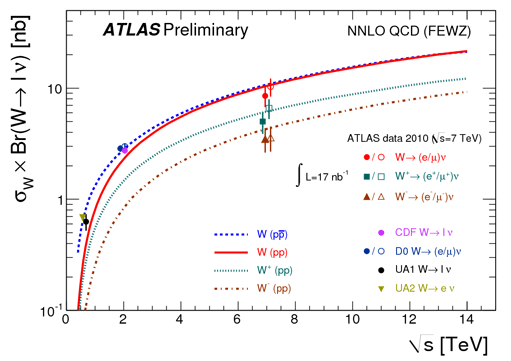
ATLAS e-News
23 February 2011
W/Z latest
27 July 2010

Comparison of W cross-section measurements with theoretical predictions, for UA1 and UA2 (cluster 1), the Tevatron (cluster 2) and ATLAS (cluster 3). The ATLAS measurements include W+, W- and the sum of these, with closed datapoints denoting electrons and open datapoints denoting muons. Datapoints within clusters are staggered to improve readability.
“Right now, this is the 'flagship' analysis, if you like,” smiles Joao Guimaraes da Costa, co-Leader of the W/Z muon working group. The note in his hand, destined for the ICHEP conference, details W- and Z- boson observations and cross-section measurements at ATLAS so far, and represents the first high momentum (high pT) physics seen by the experiment.
These well-defined Standard Model particles were first seen at CERN's proton-antiproton collider in 1982 and 1983, but “rediscovering” them with the LHC allows the experiments to gauge how well they're performing in these early days.
After the W and Z, the next big physics object on the list is the top quark. When one shows up at the LHC (several candidates have already been identified), it will be the first time it has been seen at a European accelerator. Understanding the experiment's response to W and Z particles is a crucial step in picking the top quark out, Joao explains:
“It decays into a W. And many of the other new physics processes will often involve Ws and Zs, so these signatures are very common and will end up contributing to top [physics] and many others.”
The ICHEP note focuses mainly on Ws, which are more plentiful in data, with their production rate a factor of 10 higher than that of Zs. Although calculated from Standard Model physics, the production rates of both bosons at the previously un-explored energy scale of the LHC have not been measured until now.
The cross-section of the W – the probability of it being produced – was already calculated and included in the first draft of the paper. By the time the machine went into a technical stop last week, ATLAS had collected 338 nb-1, of which enough could be analysed in time to allow a decent Z cross-section measurement to be built into the note too.
“We'll try to include as much of that data as possible by the 21st, to take to ICHEP,” was Joao's summary of the plan, during an interview on July 14th. The W cross-section measurement method was approved by July 16th, based on 17 nb-1
of data. The Z cross-section, which requires more data due to its lower production rate, but is speedier to calculate since it doesn't require missing energy measurements, was slipped in at the last minute with 225 nb-1 of data behind it.
The paper, which compares data to theoretical predictions, is an update of what was taken to the PLHC conference in June, where cross-sections weren't yet extracted from the data. With over ten times more data at hand now, all the other plots in the paper have been brought right up-to-date. As well as refining the calculations of the transverse mass of the W and the mass of the Z, anomalies from the previous paper have been ironed out:
“The major thing [in June] was that we had some expectation from the Standard Model, but we saw more muons than expected and fewer electrons than expected,” says Joao, referring to the two different channels in which a W boson might decay (to a neutrino with either an electron or a muon).
With the enlarged dataset, this was a trend that didn't persist; it completely disappeared with the increase in statistics. “Without changing the analysis, the numbers are now totally consistent with the Standard Model.”
At the LHC, W and Z bosons are being produced in proton-proton collisions (as opposed to proton-antiproton or electron-positron collisions) for the first time, and as such Ws are produced with a bias towards W+ particles. As well as ATLAS observations falling close to theoretical predictions for the W+ and W- cross-sections, this characteristic asymmetry is also tentatively geometrically visible – with more W+s being observed in the barrel region and more W-s showing up in the forward regions – a feature which is also explored in the paper.
“In terms of the Standard Model, there is nothing new to see here, but it will be interesting to see what CMS comes up with,” Joao smiles, looking ahead to the reaction of the wider physics community at ICHEP. “It tells you whether the experiments are in good shape.”
“Eventually, we will have millions of these particles and we will be able to study them in detail at the new energy scale," he adds. “With more statistics, the measurements we are doing will provide unprecedentedly detailed studies of the proton structure, which will be important for the understanding of all other physics at the LHC, and tests of Quantum Chromodynamics calculations.”
A total of 118 W candidates and 125 Z candidates were used for the cross-section measurements. In a message to the Collaboration last Wednesday, Physics Coordinators Tom Le Compte and Aleandro Nisati expressed everyone's appreciation of the quick turn-around time on the Z cross-section: “Congratulations to all of ATLAS for producing such a nice result so quickly!”

Comparison of Z cross-section measurements with theoretical predictions, for UA1 and UA2 (cluster 1), the Tevatron (cluster 2) and ATLAS (cluster 3), with closed datapoints denoting electrons and open datapoints denoting muons. Datapoints within clusters are staggered to improve readability.
 Ceri PerkinsATLAS e-News
|